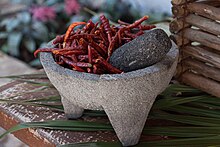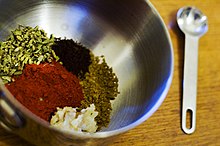I love spicy food so Mexican food that I love making and eating out at small moms pops eateries to nice sit down restaurants. Even though I am not native to Mexico and my knowledge about Mexican cuisine is little, I went out to find all about Mexican cuisine to write this post and I simply amazed at what I learned which I am sharing below about Family and culturally oriented Mexican Cuisine.Mexican cuisine is closely tied to the culture, social structure and popular traditions of the country. The most important example of this connection is the use of mole for special occasions and holidays, particularly in the South and Center regions of the country. The basic staples remain native foods such as corn, beans and chili peppers, but the Europeans introduced a large number of other foods, the most important of which were meat from domesticated animals , dairy products (especially cheese) and various herbs and lots of spices.
Mexican cuisine is as complex as any of the great cuisines in the world, such as those of China, France and Turkey. It is created mostly with ingredients native to Mexico as well as those brought over by the Spanish conquistadors, with some new influences since then. In addition to staples such as corn and chili peppers, native ingredients include tomatoes, squashes, avocados, cocoa and vanilla, as well as ingredients not generally used in other cuisines such as edible flowers, vegetables such as huauzontle and papaloquelite or small criollo avocados, whose skin is edible. European contributions include pork, chicken, beef, cheese, herbs and spices and some fruits. Tropical fruits such as guava, prickly pear, sapote, mangoes, bananas, pineapple and cherimoya (custard apple) are popular, especially in the center and south of the country.
Street Food- Fast Mexican Food:
Mexican street food is one of the most varied parts of the cuisine. It can include tacos, quesadillas, tortas and, tamales. One attraction of street food in Mexico is the satisfaction of hunger or craving without all the social and emotional connotation of eating at home, although longtime customers can have something of a friendly relationship with vendor they eat from.
The best known of Mexico’s street foods is the taco, whose origin is based on the pre-Hispanic custom of picking up other foods with tortillas as utensils were not used. Tacos are not eaten as the main meal; they are generally eaten before midday or late in the evening as snacks. Just about any other foodstuff can be wrapped in a tortilla and in Mexico it varies from rice, to meat (plain or in sauce) to vegetables and cheese. Preferred fillings vary from place to place with pork generally found more often in the center and south, beef in the north, seafood along the coasts and chicken in most of the country. You can have vegetarian tacos in US or make it at home with beans and vegetables.
Click here for Mexican Recipes and Cookbooks

Tortas being prepared
Click here for Mexican Cookbooks and Recipes
Another popular street food, especially in Mexico City and the surrounding area is the torta. It consists of a roll of some type, stuffed with several ingredients. The torta began by splitting the roll and adding beans. Today, refried beans can be still be found on many kinds of tortas. In Mexico City, the most common roll used for tortas is called telera, a relatively flat roll with two splits on the upper surface.
In the 20th century, US influence has been strong. One example of this is the appearance of the hot dog, but prepared Mexican style. They are usually boiled then wrapped in bacon and fried. They are served in the usual bun, but the condiments are usually some combination of tomatoes, onions and chili peppers.
Northern Mexican Cuisine:
The foods eaten in what is now the north of Mexico have differed from those in the south. When the Europeans arrived, they found much of the land in this area suitable for raising cattle, goats and sheep. This led to the dominance of meat, especially beef, in the region, and some of the most popular dishes include machaca, arrachera. The region’s distinctive cooking technique is grilling, as ranch culture has promoted outdoor cooking done by men. The ranch culture has also prompted cheese production and the north produces the widest varieties of cheese in Mexico. These include queso fresco (fresh farmer’s cheese), rancher (similar to Monterey Jack), cuajada (a mildly sweet, creamy curd of fresh milk), requesón (similar to cottage cheese or riccotta), Chihuahua’s creamy semi-soft queso menonita and fifty-six varieties of asadero (smoked cheese).
Another important aspect of northern cuisine is the presence of wheat, especially in the use of flour tortillas. The area has at least forty different types of flour tortillas. These large tortillas allowed for the creation of burritos, usually filled with machaca in Sonora, which eventually gained popularity in the Southwest United States.
The variety of foodstuffs in the north is not as varied as in the south of Mexico because of the mostly desert climate. Much of the cuisine of this area is dependent on food preservation techniques, namely dehydration and canning. Dried foods include meat, chili peppers, squash, peas, corn, lentils, beans and dried fruit. A number of these are also canned. Preservation techniques change the flavor of foods; for example, many chili peppers are less hot after drying.[48]
The north has seen waves of immigration by Chinese, Mormons, and Mennonites, who have influenced the cuisines in areas such as Chihuahua and Baja California. Most recently, Baja Med cuisine has emerged in Tijuana and elsewhere in Baja California, combining Mexican and Mediterranean flavors.
Oaxacan cuisine
Oaxaca was the first area to experience the mixing of foods and cooking styles, while central Mexico was still recuperating. Despite its size, the state has a wide variety of ecosystems and a wide variety of native foods. Vegetables are grown in the central valley, seafood is abundant on the coast and the area bordering Veracruz grows tropical fruits. It also adapted mozzarella, brought by the Spanish, and modified it to what is known now as Oaxaca cheese.
One major feature of Oaxacan cuisine is its seven moles, second only to mole poblano in importance. The seven are Negro (black), Amarillo (yellow), Coloradito (little red), Mancha Manteles (table cloth stainer), Chichilo (smoky stew), Rojo (red), and Verde (green). Corn is the staple food in the region. Tortillas are called blandas and part of every meal. Corn is also used to make empanadas, tamales and more. Black beans are favored, often served in soup and as a sauce for enfrijoladas. Another important aspect to Oaxacan cuisine is chocolate, generally consumed as a beverage. It is frequently hand ground and combined with almonds, cinnamon and other ingredients
Yucatan Cuisine:
The food of the Yucatán peninsula is distinct from the rest of the country. It is based primarily on Mayan food with influences from the Caribbean, central Mexico, European (especially French) and Middle Eastern cultures.As in other areas of Mexico, corn is the basic staple, as both a liquid and a solid food. One common way of consuming corn, especially by the poor, is a thin drink or gruel of white corn called by such names as pozol.
One of the main spices in the region is the annatto seed, called achiote in Spanish. It gives food a reddish color and a slightly peppery smell with a hint of nutmeg.Recados are a seasoning paste based on achiote and used on meat. Pibil refers to the cooking method in which foods are wrapped, generally in banana leaves, and cooked in a pit oven. Various meats are cooked this way. Habanero chilis are another distinctive ingredient, but they are generally served as condiments on the side rather than integrated into the dishes.
One prominent feature of Yucatán cooking is tropical fruits such as tamarind, plums, mamey, avocados and bitter oranges, the last often used in the region’s distinctive salsas. Honey was used long before the arrival of the Spanish to sweeten foods and to make a ritual alcoholic drink called balché.Street food in the area usually consists of Cochinita Pibil Tacos, Lebanese-based Kibbeh, snacks made of hardened corn dough called piedras and fruit-flavored ices.
Mexican Drinks:
Corn in Mexico is not only eaten but also drunk. Corn is the base of the hot drink called atole, which is then flavored with fruit, chocolate, rice and other flavors. Fermented corn is the base of a cold drink as well which goes by different names and varieties. Aguas frescas are flavored drinks usually made of fruit, water and sugar. Beverages also include hibiscus iced tea, one made from tamarind and one from rice called “horchata.” One variant of coffee is café de olla, which is coffee brewed with cinnamon and raw sugar.[43]
Chocolate played an important part in the history of Mexican cuisine. The word “chocolate” originated from Mexico’s Aztec cuisine. Chocolate was first drunk rather than eaten. It was also used for religious rituals. The Maya civilization grew cacao treesand used the cacao seeds it produced to make a frothy, bitter drink.The drink, called xocoatl, was often flavored with vanilla, chili pepper, and achiote. Alcoholic beverages from Mexico include tequila, pulque, aguardiente and mezcal, with brandy, wine, beer and rum also produced. The most common alcoholic beverage consumed with food in Mexico is beer, followed by tequila.



